
Wine Culture and Information since 2002 - Volume 23
 Wine Culture and Information since 2002 - Volume 23 |
|
Tasting Sparkling WinesIndisputable stars in moments of celebration, sparkling wines always evoke a special magic which is freed from the glass by means of a continuous chain of transparent pearls and of their appealing aromas |
|
A discrete whisper, but also a sudden bang, in the worst and unwanted cases, and suddenly the attention of everyone is caught by that bottle that more than any other else evokes happy moments and of celebration, with its crystalline liquid often accompanies the important moments of people's life: sparkling wine. The role usually recognized to sparkling wines, that is to be consumed in holidays, is a sort of curse for them but also a huge luck. Few people cannot resist to the charm of a sparkling wine, maybe because its presence in the glass gives people the illusion of living an important moment to which everyone must take part. Since ever the charm of sparkling wines, it would be useless to deny it, in particular Champagne, served in glasses capable of exalting the most mysterious and magic aspect, bubbles, gave people special moments of happiness in the name of that ancient tradition of French noblemen where the availability of Champagne were not a problem at all, and bottles were often and willingly uncorked. Even though it must be said Champagne has the indisputable merit of having allowed bubbles to be famous and looked for in every part of the world, it should be remembered there also are other sparkling wines with excellent quality produced in many wine producing countries. Sparkling wines are not just “bubbles”, their charm is also made by their delicate and refined aromas and, last but not the least, by their refreshing and appealing taste.
|
|
In general terms, every time sparkling wines are taken into consideration, the style referred is always white, as a matter of fact, the most produced and appreciated one, however there also are red sparkling wines, such as the renowned Brachetto. We will not discuss much about the color of red sparkling wines, a factor greatly affected by the grape used for their production, however it can be said the color of these wines always ranges from deep pink to pale red. It should also be remembered there are rose sparkling wines, in particular the ones produced with the classic method, such as Champagne and Franciacorta, real and proper enological pearls, excellent examples of elegance and finesse. In white sparkling wines the color is mainly determined by the grapes used for the production, and in case of classic method wines, by the time spent in contact with yeasts and the aging time after the disgorgement. The color of sparkling wines produced with the Charmat method is usually greenish yellow and in some cases is pale straw yellow with evident nuances of greenish yellow. In white sparkling wines produced with the classic method, the young ones and the ones produced with white berried grapes only, the so called “blanc de blancs”, the color will be pale straw yellow with evident nuances of greenish yellow, anyway a light and pale color is always the sign of a young wine. In sparkling wines produced with red berried grapes and blended with white grapes, the color is usually straw yellow with nuances of golden yellow, whereas in sparkling wines exclusively produced with red berried grapes, the so called “blanc de noirs”, the golden color will be more evident. After disgorgement, because of the effects of oxygen, a slow but inexorable oxidization will turn colors into deeper and darker tints of increasing intensity. In rose sparkling wines the color mainly depends on the quantity of red wine used in the cuvée, usually Pinot Noir, which will give the wine tints ranging from pale pink to intense salmon pink.
|
|
Among the most charming aspects of sparkling wines, among the ones that usually catch the attention the most, is effervescence, the continuous and joyous fountain of bubbles which emerges to the surface from the bottom of the glass. Bubbles are usually a clear sign about the quality of a sparkling wine as well as the quality of the production technique, however also froth plays an important role in the appearance evaluation of these wines. The substance responsible for the formation of these two factors, froth and bubbles, is carbon dioxide (CO2) which is formed during production, whereas the development is regulated by physical factors that take place in the glass, in particular the temperature and hygiene of glass.
Temperature, in particular, has a fundamental effect on the development of bubbles: at low temperatures the releasing of carbon dioxide is slower and perlage, that is the development of bubbles, will last longer. On the other hand, at high temperatures carbon dioxide is quickly released and sparkling wine loses its effervescence. Another factor which regulates the releasing of carbon dioxide is the surface of contact; the larger, the quicker it will be dispersed. For this reason are preferred narrow and tall glasses, the so called flûte, just because they have a rather narrow surface of contact while ensuring a slow, lasting and continuous releasing of carbon dioxide. The aspect and the development of froth is regulated, besides by the conditions of the glass, also by the quantity of certain substances in wine, such us proteins, which directly affect its formation, structure and stability. The first aspect to be evaluated is froth, the way it gets formed and develops, as well as its vanishing. Just after having poured a sparkling wine in the glass, it will be possible to observe an abundant formation of froth which will tend to vanish within seconds, while allowing the formation of a less abundant and less visible froth along the border of the glass. it will be this crown what will be observed during the evaluation of froth (figure ). It will be observed its persistence and the size of bubbles, the finer the bubbles, the higher the quality of wine. The crown is first observed holding the glass with no movement and evaluating its evolution, then it will be evaluated again after having slightly rotated the glass. Froth must not be nor too thick nor creamy and it must vanish within seconds while allowing the formation of the crown. After having evaluated froth, the next phase will be the evaluation of bubbles, their quality and development. It must be said bubbles' size, one of the factors making quality in sparkling wines, is mainly determined by the technique used for production: in Charmat method wines, bubbles are usually coarser and bigger, and therefore less fine, than a classic method wine. However it must be remembered there are differences from a classic method to another: the skill and mastery of the producer is also expressed by how the classic method technique was used and this is easily confirmed by the size of bubbles: the finer and smaller, the higher the quality of the sparkling wine and the better the effects of carbon dioxide will play on the many organoleptic qualities of wine. It will be observed the quantity of bubbles developing from the bottom of the glass and how they evolve as they reach the surface. A good quality sparkling wine always has fine bubbles, having the size of a pin point, and perlage must last for a long time. Even velocity at which bubbles reach the surface of the glass is a sign of quality and it must be rather slow and continuous. Bubbles evolving like that are the sign of a correct and good making technique and therefore of a high quality wine. It will be now observed the glass from the top and it will be evaluated the development of bubbles as they reach the surface. Bubbles, after having reached the surface will tend to move to the side of the glass while forming a crown along the border. Also in this case the bubbles of the crown must have a small size, long persistence and they will be present in high quantity, once again, these are signs of a quality production. Moreover, it must be remembered the formation and the quality of the crown also depend by the condition of the glass: in a dirty glass or washed with soap, the phenomenon will be less evident and persistent; a good reason for taking good care of glasses before pouring a sparkling wine to be evaluated and before judging poorly a wine.
|
||||||||
|
As opposed to the other styles, sparkling wines have an element which promotes the development of aromas: carbon dioxide. When bubbles reach the surface, they explode and free wine's aromas, however it must be remembered a tumultuous effervescence also releases a sudden and abundant quantity of carbon dioxide with the result of irritating the nose during the evaluation of aromas. For this reason it is best to wait for the froth and the initial and tumultuous effervescence to vanish before proceeding to the olfactory analysis of a sparkling wine. The olfactory characteristic of a sparkling wine is delicacy and finesse of aromas, factors which are determined both by the production technique and the quality of grapes and cuvée. Sparkling making technique affects the quality and type of aromas: the Charmat method, generally used for aromatic grapes, favors the development of fruit, flower and fresh aromas, whereas the classic method adds to the freshness of fruit and flower aromas a superior aromatic complexity whose intensity depends by the grapes and the quantity of time the wine has been in contact with yeasts at the end of the second fermentation in bottle. In particular, in classic method sparkling wines, a fundamental role is played by yeasts and by the time they stay in contact with wine. At the end of the refermentation in bottle, when the sugar is completely transformed into alcohol, yeasts die and begins a decomposition process, called autolysis, which enriches both the aromatic complexity and the gustatory richness of sparkling wine. In young sparkling wines, the main aromas will be the ones of fresh fruit and flowers, in particular, in white sparkling wines, aromas of citrus fruit, such as lemon and grapefruit, as well as aromas of fruit such as apple, pear, peach and apricot. In rose sparkling wines will also be perceived aromas of red skinned fruit such as raspberry, strawberry and cherry, mainly because of the presence of Pinot Noir, the main red berried grape used in rose sparkling wines, in particular the ones made with the classic method. Also the range of exotic fruit aromas is pretty intense, such as litchi, mango, passion fruit, banana and pineapple. Flower aromas mainly resemble the ones of white flowers, typical in any white wine, such as acacia, orange blossom, hawthorn and, in rose sparkling wines, it can also be perceived an aroma of violet. In case the sparkling wine was produced with a wine aged in cask, a practice generally used for some classic methods, it will also be possible to perceive aromas of spices such as anise, cinnamon, clove, black pepper, licorice, nutmeg and vanilla. Moreover, vegetal aromas and aromatic herbs can be perceived as well. What makes classic method sparkling wines charming and appealing are also the complexity of their aromas, passed by decomposed yeasts, as well as by the aging in bottle after disgorgement, such as aromas of yeast, wax and candied fruit, as well as surprising aromas of fresh butter, brioche, honey, toasted bread and caramel, aromas that can be perceived only in sparkling wines which spent a long time in contact with yeasts at the end of the refermentation in bottle. In aromatic sparkling wines produced with the Charmat method, such as Asti Spumante and Brachetto, the main aroma will be dominated by the one of grape, a clean and intense aromatic hint which is practically impossible not to smell.
|
||||
|
Carbon dioxide also plays an important role on the taste of sparkling wines. The taste of this gas is slightly acid, but its main effect is perceivable by means of effervescence, a tactile sensation expressed by a “pungency” in the oral cavity. However the basically acid taste of carbon dioxide will be added to the one of wine with the result of increasing this taste, moreover, it diminishes the perception of sweet flavors, and therefore the perception of alcohol as well, and strengthen the astringency of tannins. Carbon dioxide is therefore useful to mitigate the sweetness in sweet sparkling wines, a providential help in order not to make these wines taste sickly. However sugar plays a fundamental role in sparkling wines' balance. Like we said, carbon dioxide has the capacity of exalting acid tastes in wine, a condition that would make any wine taste unpleasing, moreover it has the capacity of attenuating the sweet tastes, and sweetness has the capacity of balancing acidity and to make it taste more pleasing and acceptable: just think of the agreeability of lemon juice with and without sugar. In sparkling wines, in order to have a better gustatory balance, it is added, at the end of the production, a sweet mixture, made of sugar, wine and other “secret” ingredients, usually a little quantity of brandy, called “liqueur d'expedition” which helps to mitigate the acid taste while increasing the roundness and the sweetness of wine. According to the quantity of sugar present in sparkling wines they are classified according to the terms listed in table . Despite a brut sparkling wine may contain up to 15 grams of sugar per liter, a quantity that would make sweetness clearly perceivable in a still wine, thanks to carbon dioxide and to its effects on taste, the sparkling wine will seem to be rather dry.
During the gustatory evaluation of a sparkling wine it will be paid attention not to moving much the wine in the mouth especially in a violent way: this operation would favor a sudden and abundant release of carbon dioxide that would anesthetize taste buds and therefore it would not allow a proper perception of tastes. Balance in sparkling wines is determined by the same factors in white wines as well as the effects carbon dioxide has on acid and sweet components. Acidity of a sparkling wine will never be exaggeratedly evident, indeed it will must be perceived as a pleasing crispness. The same is also true for effervescence which must not be exaggerated or irritant; besides lowering the gustatory perception, excessive quantities of gas in the mouth would only give origin to a uncomfortable gustatory sensation. The perception and intensity of sweetness mainly depend on the type of sparkling wine being evaluated (see table ), therefore a sweet sparkling wine will have a rather evident sweetness as opposed to an extra brut which will taste absolutely dry. Sweetness in sparkling wines is therefore a characteristic of typicality, however it must never be sickly, it must however be balanced with the acid component of the wine. At the same way, in dry sparkling wines, where the sensation of sweetness is lesser and apparently absent, acidity must never be aggressive. Even structure, or body, of a sparkling wine is a factor that must not be neglected. In sparkling wines produced with the Charmat method, structure is usually lighter, whereas in classic method wines it will be more robust. In the so called “blanc de blancs”, exclusively made with white berried grapes, it will be mainly appreciated delicacy and finesse of taste and flavors. In classic method sparkling wines in which red berried grapes are present, the perception of structure will be more evident, a sensation that will be more evident in “blanc de noirs” sparkling wines, exclusively produced with red berried grapes.
|
||||||||||||||||||||||
|
In our practical application for the evaluation of sparkling wines, we will examine the different styles of wines: Asti Spumante, Prosecco di Valdobbiadene Brut and Franciacorta Brut or a Champagne Brut. All three wines will be served at proper temperatures: 8° C for Asti and Prosecco (46° F), 10° C for Franciacorta (50° F). The first aspect we are going to evaluate is effervescence and perlage. In all the three wines froth will vanish within seconds and it will be possible to observe the crown of bubbles in the border of glasses. Asti and Prosecco, both made with Charmat method, will have similar perlage and however rather different when compared to the one of Franciacorta. In the first two wines the size of bubbles will be bigger whereas in Franciacorta the size will be finer and the perlage will be more persistent. Also the color will show evident differences: Asti and Prosecco will have a pale straw yellow color whereas Franciacorta will have a more intense color, straw yellow and possibly nuances of golden yellow. The color depends both by the grapes used and by the production technique. To the nose the three wines will appear different one from each other. Asti Spumante will offer an appealing and fragrant aroma of Muscat grape and peach, as well as apple and pear and, possibly, aromas of sage and citrus fruits. However it will be the aroma of Muscat grape the one to prevail over the other ones, after all this is a fundamental characteristic of this wine. In the Prosecco will be absent the aromatic intensity of Asti, here aromas will be fresh and charming of apple, pear, almond and peach, as well as aromas of flowers such as hawthorn and broom. Lastly will be evaluated Franciacorta's aromas: the difference and the aromatic complexity compared to the other ones should be clearly evident. In this wine will be perceived aromas of yeast, toasted bread, butter and hazelnut, as well as aromas of fruit such as citrus fruits, banana, pineapple, apple and pear, and aromas of flowers such as hawthorn. The first wine to be evaluated at the taste will be Prosecco. Effervescence will be very evident and the wine will seem to have a rather dry taste, with a delicate structure and a pleasing and refreshing crispness. The second wine to be evaluated will be Franciacorta. The first impact will be very different from Prosecco, here the structure is more robust and evident, effervescence will probably be less aggressive and the wine will seems to be rounder no matter acidity will be clearly perceivable, refreshing and agreeable. Lastly, it will be evaluated Asti Spumante: the first impact in the mouth will be the result of sweetness and effervescence, both to be considered as primary characteristics of this wine, as well as the typical taste of Muscat grape, taste and flavors completely absent in the other two wines. Effervescence in this wine will seem to be more aggressive and strong, however it will be noticed the balance between wine's sweetness and acidity, clearly perceivable.
|
Wines of the Month |
|
|
|
Score legend Prices are to be considered as indicative. Prices may vary according to the country or the shop where wines are bought |
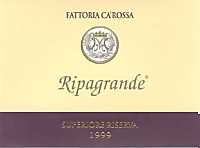
|
|
Sangiovese di Romagna Superiore Ripagrande 1999 |
|
| Fattoria Ca' Rossa (Italy) | |
| Grapes: Sangiovese | |
| Price: € 15,00 | Score: |
| The wine shows a brilliant ruby red color and nuances of orange/brick red, moderate transparency. The nose reveals intense, clean, elegant and pleasing aromas of black cherry jam, blueberry jam, blackberry jam, plum jam and dried violet followed by intense and good aromas of chocolate, black pepper and vanilla. In the mouth denotes good correspondence to the nose, a slightly alcoholic attack however well balanced by tannins, full body and intense flavors. The finish is persistent with clean flavors of plum jam, blackberry jam and black cherry jam. A well made wine. This Sangiovese ages in barrique for at least 12 months followed by a 6-12 months of aging in bottle. | |
| Food Match: Game, Roasted meat, Braised and stewed meat, Hard cheese | |
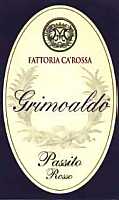
|
|
Grimoaldo 2001 |
|
| Fattoria Ca' Rossa (Italy) | |
| Grapes: Terrano | |
| Price: € 7,00 (500ml) | Score: |
| The wine shows a deep ruby red color and nuances of purple red, little transparency. The nose has good, intense, pleasing and clean aromas of black cherry jam, cherry jam, blueberry jam, blackberry jam, violet, chocolate and vanilla. In mouth has good correspondence to the nose, a tannic attack however well balanced, intense flavors and agreeable sweetness. The finish is persistent with flavors of blueberry jam and black cherry jam. Grimoaldo is fermented and aged in barrique. | |
| Food Match: Red berried fruit tarts, Hard cheese | |
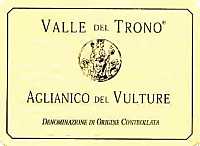
|
|
Aglianico del Vulture Valle del Trono 2000 |
|
| Basilium (Italy) | |
| Grapes: Aglianico | |
| Price: € 23,00 | Score: |
| The wine shows an intense ruby red color and nuances of ruby red, moderate transparency. The nose reveals intense, pleasing and clean aromas of black cherry, raspberry, blueberry, violet and carob followed by pleasing hints of chocolate, licorice, black pepper and tobacco. In the mouth has good correspondence to the nose, a slightly tannic attack however balanced by alcohol, intense flavors and good body. The finish is persistent with good flavors of raspberry, black cherry and plum. This Aglianico is produced with partially dried grapes and ages in cask for 24 months. | |
| Food Match: Roasted meat, Braised meat with mushrooms, Hard cheese | |
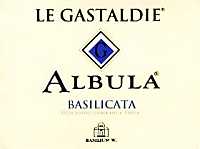
|
|
Le Gastaldie Albula 2001 |
|
| Basilium (Italy) | |
| Grapes: Aglianico | |
| Price: € 8,00 | Score: |
| This wine, produced with Aglianico grape vinified with white wine making process, shows a brilliant greenish yellow color and nuances of greenish yellow, very transparent. The nose reveals intense and pleasing aromas with a well balanced hint of toasted wood. There can be perceived aromas of acacia, citrus fruit, banana, broom, medlar, pear, peach and vanilla. In mouth reveals good correspondence to the nose, a slightly crisp attack however balanced and intense flavors. The finish is persistent with good flavors of peach, medlar and vanilla. | |
| Food Match: Soft cheese, Pasta and risotto with vegetables, Eggs, Sauteed white meat | |
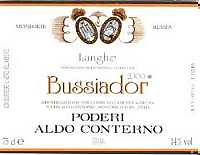
|
|
Langhe Chardonnay Bussiador 2000 |
|
| Poderi Aldo Conterno (Italy) | |
| Grapes: Chardonnay | |
| Price: € 22,00 | Score: |
| The wine shows an intense straw yellow color and nuances of straw yellow, very transparent. The nose denotes personality with intense, clean, elegant and pleasing aromas of acacia, banana, pineapple, hawthorn, apple, litchi, jasmine, grapefruit and hazelnut followed by intense and good hints of vanilla, coffee, butter and aromas of toasted wood. In mouth has good correspondence to the nose, good body, balance and intense flavors, agreeable crispness. A well made wine. The finish is persistent with good flavors of banana, pear, grapefruit and pineapple. This Chardonnay ferments in barrique and ages for 12 months in barrique. | |
| Food Match: Roasted fish, Stuffed pasta, Sauteed and roasted white meat | |
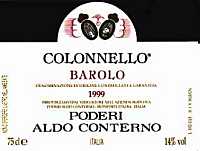
|
|
Barolo Colonnello 1999 |
|
| Poderi Aldo Conterno (Italy) | |
| Grapes: Nebbiolo | |
| Price: € 56,00 | Score: |
| This wine shows a light ruby red color and nuances of garnet red, moderate transparency. The nose has personality and intense, pleasing, elegant and refined aromas of black cherry jam, raspberry jam, plum jam and violet followed by good aromas of cocoa, leather, licorice, tobacco and vanilla. In mouth has good correspondence to the nose, an alcoholic attack well balanced by tannins, intense flavors and full body. The finish is persistent with clean flavors of raspberry, plum and cherry. A well made wine. Barolo Colonnello is aged for 26-28 months in cask. | |
| Food Match: Game, Roasted meat, Braised meat, Stewed meat, Hard cheese | |
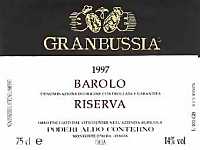
|
|
Barolo Granbussia Riserva 1997 |
|
| Poderi Aldo Conterno (Italy) | |
| Grapes: Nebbiolo | |
| Price: € 89,00 | Score: |
| A magnificent Barolo! This wine shows a beautiful and brilliant garnet red color and nuances of orange/brick red, moderate transparency. The nose reveals strong personality with intense, elegant, pleasing and very clean aromas of black cherry jam, strawberry jam, raspberry jam, blueberry jam, plum jam and dried violet followed by elegant and refined aromas of anise, cinnamon, chocolate, leather, licorice, mint, rosemary, thyme and vanilla. In the mouth has excellent correspondence to the nose, a slightly crisp attack however well balanced by alcohol, good and balanced tannins, intense flavors and full body. The finish is very persistent with long and clean flavors of plum, black cherry, blueberry and raspberry. A great wine. Granbussia riserva is produced only in the best years with wines from Romirasco, Cicala and Colonnello vineyards, ages for 26-28 months in cask followed by 6 years of aging in cellar. | |
| Food Match: Game, Braised and stewed meat, Roasted meat, Hard cheese | |

|
|
Verdicchio dei Castelli di Jesi Classico Le Vele 2002 |
|
| Terre Cortesi Moncaro (Italy) | |
| Grapes: Verdicchio | |
| Price: € 4,90 | Score: |
| The wine shows a brilliant straw yellow color and nuances of straw yellow, very transparent. The nose reveals intense, clean, pleasing and elegant aromas of citrus fruits, hawthorn, broom, litchi, apple, pear, peach and plum. In the mouth is balance since the very beginning, good body, intense flavors and good correspondence to the nose. The finish is persistent with pleasing flavors of peach, pear and plum. A well made Verdicchio. | |
| Food Match: Pasta and risotto with fish, Crustaceans, Roasted fish | |
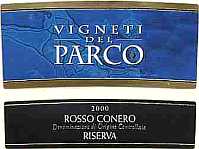
|
|
Rosso Conero Riserva Vigneti del Parco 2000 |
|
| Terre Cortesi Moncaro (Italy) | |
| Grapes: Montepulciano | |
| Price: € 12,00 | Score: |
| This Rosso Conero shows a beautiful and deep ruby red color and nuances of ruby red, little transparency. The nose reveals good personality with intense, clean, elegant, pleasing and refined aromas of black cherry jam, plum jam, blueberry, blackberry, black currant, violet and carob followed by pleasing and good aromas of licorice, chocolate, tobacco and vanilla. In the mouth has good correspondence to the nose, good balance and agreeable tannins, intense flavors and good body. The finish is persistent with clean and intense flavors of plum, black cherry and blackberry. A well made wine. This Rosso Conero ages for about 2 years in barrique and for at least 6 months in bottle. | |
| Food Match: Game, Roasted meat, Braised meat, Stewed meat, Hard cheese | |
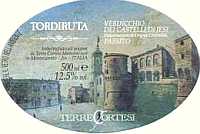
|
|
Verdicchio dei Castelli di Jesi Passito Tordiruta 2000 |
|
| Terre Cortesi Moncaro (Italy) | |
| Grapes: Verdicchio | |
| Price: € 17,20 - 500ml | Score: |
| The wine shows a beautiful and brilliant amber yellow color and nuances of golden yellow, very transparent. The nose reveals personality with intense, pleasing, clean, refined and very elegant aromas of dried apricot, candied fruit, quince jam, peach jam, almond, orange peel, honey and dried flowers followed by pleasing and intense aromas of caramel, enamel, vanilla and saffron as well as the pleasing and typical aroma of noble rot (Botrytis Cinerea). In the mouth has excellent correspondence to the nose, velvety and very agreeable with a well balanced sweetness, intense flavors and good structure. The finish is very persistent, almost endless, with clean and intense flavors of dried apricot, peach jam and quince jam. A great and very well made sweet wine. Tordiruta is produced with late harvested grapes affected by noble rot and dried in mats for 10 weeks, ferments and ages in barrique for 12 months followed by one year of aging in bottle. | |
| Food Match: Hard and piquant cheese, Fruit tarts, Strüdel | |
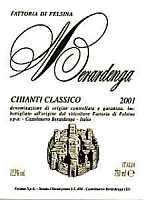
|
|
Chianti Classico 2001 |
|
| Fattoria di Felsina - Berardenga (Italy) | |
| Grapes: Sangiovese | |
| Price: € 14,00 | Score: |
| This Chianti shows a brilliant ruby red color and nuances of ruby red, moderate transparency. The nose reveals pleasing and clean aromas, mainly of fruit, such as black cherry, raspberry, blueberry, plum and violet followed by pleasing hints of vanilla. In mouth has good correspondence to the nose, a right quantity of tannins which make it very agreeable, intense flavors, good body and very balanced. The finish is persistent with flavors of plum, raspberry and black cherry. This wine ages in cask for 12 months followed by 3-6 months of aging in bottle. | |
| Food Match: Broiled meat and barbecue, Stuffed pasta, Hard cheese, Roasted meat | |
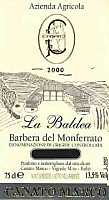
|
|
Barbera del Monferrato La Baldea 2000 |
|
| Canato Marco (Italy) | |
| Grapes: Barbera | |
| Price: € 7,50 | Score: |
| This wine shows an intense ruby red color and nuances of ruby red, little transparency. The nose reveals intense, clean and pleasing aromas of black cherry, cherry, blueberry, blackberry and plum followed by a pleasing hint of walnut. In the mouth has good correspondence to the nose, a slightly crisp attack however balanced, good body and intense flavors. The finish is persistent with good flavors of blueberry, black cherry and plum. This Barbera is aged for 12 months in steel tanks and for some months in bottle. | |
| Food Match: Roasted meat, Sauteed meat, Hard cheese | |
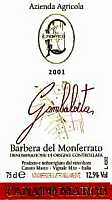
|
|
Barbera del Monferrato Gambaloita 2001 |
|
| Canato Marco (Italy) | |
| Grapes: Barbera | |
| Price: € 5,00 | Score: |
| This wine shows a brilliant ruby red color and nuances of ruby red, moderate transparency. The nose reveals pleasing, intense and clean aroma of fruits such as black cherry, raspberry, blueberry and plum followed by good aromas of violet and carob. In the mouth has good correspondence to the nose, a slightly crisp attack however balanced, good body and intense flavors. The finish is persistent with flavors of black cherry, raspberry and plum. This Barbera is aged in steel tanks and in bottle for some months. | |
| Food Match: Stuffed pasta, Sauteed meat with mushrooms, Roasted white meat | |
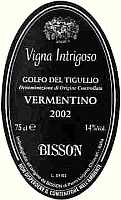
|
|
Golfo del Tigullio Vermentino Vigna Intrigoso 2002 |
|
| Bisson (Italy) | |
| Grapes: Vermentino | |
| Price: € 10,50 | Score: |
| This wine shows a brilliant greenish yellow color and nuances of greenish yellow, very transparent. The nose reveals pleasing, clean and elegant aromas of hawthorn, broom, acacia, banana, pineapple, apple, pear and peach. In the mouth has good correspondence to the nose, good balance, intense flavors and agreeable crispness. The finish is persistent with clean flavors of pineapple, pear and apple. | |
| Food Match: Dairy products, Boiled fish, Pasta and risotto with fish, Vegetable soups | |
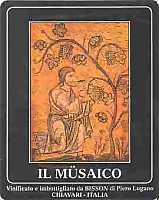
|
|
Il Müsaico 2001 |
|
| Bisson (Italy) | |
| Grapes: Dolcetto (70%), Barbera (30%) | |
| Price: € 13,20 | Score: |
| This wine shows an intense ruby red color and nuances of purplish red, moderate transparency. The nose reveals intense, pleasing, clean and elegant aromas of black cherry, blueberry, plum and violet followed by good aromas of chocolate, licorice and vanilla. In the mouth has good correspondence to the nose, good balance, intense flavors and good body. The finish is persistent with flavors of plum and blueberry. Musaico ages in cask for 12 months. | |
| Food Match: Roasted meat, Broiled meat and barbecue, Braised meat with mushrooms, Hard cheese | |
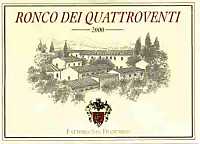
|
|
Cirò Rosso Classico Ronco dei Quattroventi 2000 |
|
| Fattoria San Francesco (Italy) | |
| Grapes: Gaglioppo | |
| Price: € 16,20 | Score: |
| The wine shows a beautiful and intense ruby red color with nuances of garnet red, little transparency. The nose has personality with clean, pleasing and elegant aromas of black cherry, blueberry jam, plum, black pepper, cardamom, chocolate and carob followed by pleasing and clean hints of eucalyptus, licorice and vanilla. In mouth reveals a good correspondence to the nose, a slightly tannic attack however balanced by alcohol, intense flavors and full body. The finish is persistent with clean flavors of black cherry, blueberry and plum. A well made wine. This red Cirò ages in barrique for 12-13 months. | |
| Food Match: Game, Braised and stewed meat, Hard cheese, Roasted meat | |
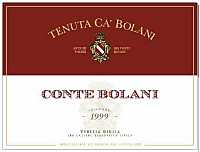
|
|
Conte Bolani 1999 |
|
| Tenuta Ca' Bolani (Italy) | |
| Grapes: Merlot (50%), Cabernet Sauvignon (30%), Refosco dal Peduncolo Rosso (20%) | |
| Price: € 19,50 | Score: |
| This wine shows a deep ruby red color and nuances of ruby red, little transparency. The nose denotes clean, pleasing, refined and elegant aromas of black cherry, strawberry, blueberry, plum and cyclamen followed by pleasing aromas of carob, chocolate, bell pepper and vanilla. In mouth reveals a slightly tannic attack however well balanced by alcohol, good correspondence to the nose, intense flavors and full body. The finish is persistent with pleasing and clean flavors of black cherry, raspberry and blueberry. A well made wine. Conte Bolani ages for 12 months in barrique. | |
| Food Match: Game, Braised and stewed meat, Hard cheese, Roasted meat | |
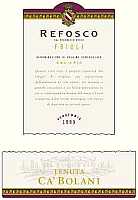
|
|
Friuli Aquileia Refosco dal Peduncolo Rosso 1999 |
|
| Tenuta Ca' Bolani (Italy) | |
| Grapes: Refosco dal Peduncolo Rosso | |
| Price: € 11,00 | Score: |
| The wine shows a deep ruby red color and nuances of ruby red, little transparency. The nose denotes clean, elegant and pleasing aromas of black cherry, blueberry, blackberry, plum and violet followed by clean aromas of carob, chocolate, licorice and vanilla. In mouth has good correspondence to the nose, a slightly tannic attack however well balanced by alcohol, intense flavors and full body. The finish is persistent with pleasing and clean flavors of black cherry, plum and blueberry. A well made wine. This Refosco ages for 12 months in barrique followed by at least 6 months of aging in bottle. | |
| Food Match: Roasted meat, Braised and stewed meat, Hard cheese | |

|
|
Moscato d'Asti 2002 |
|
| Castello del Poggio (Italy) | |
| Grapes: Muscat Blanc | |
| Price: € 7,70 | Score: |
| This wine shows an intense greenish yellow color and nuances of greenish yellow, very transparent. The nose reveals the typical aroma of Muscat grape as well as intense, clean and pleasing aromas of peach, apple, pear, citrus fruit, broom and sage. In the mouth has good correspondence to the nose, agreeable effervescence and good balance with very pleasing and balanced sweetness and crispness, intense flavors. The finish is persistent with good flavors of Muscat grape, peach and pear. | |
| Food Match: Cream dessert, Fruit salads, Semifreddo | |
|
||||||||
|
DiWineTaste Polls
|
| |||||||
Privacy Policy | |||||||


| Copyright © 2002-2024 Antonello Biancalana, DiWineTaste - All rights reserved |
| All rights reserved under international copyright conventions. No part of this publication and of this WEB site may be
reproduced or utilized in any form or by any means, electronic or mechanical, without permission in writing from DiWineTaste. |